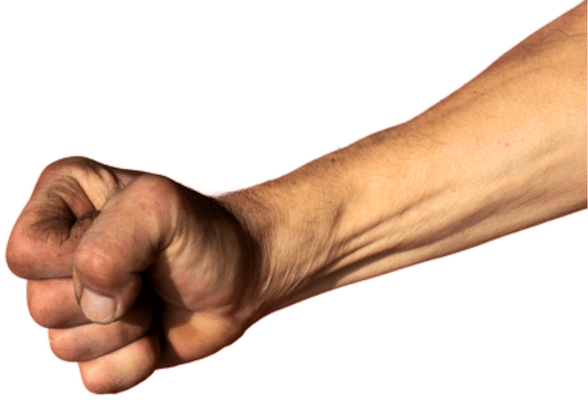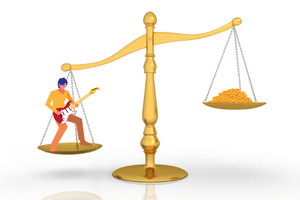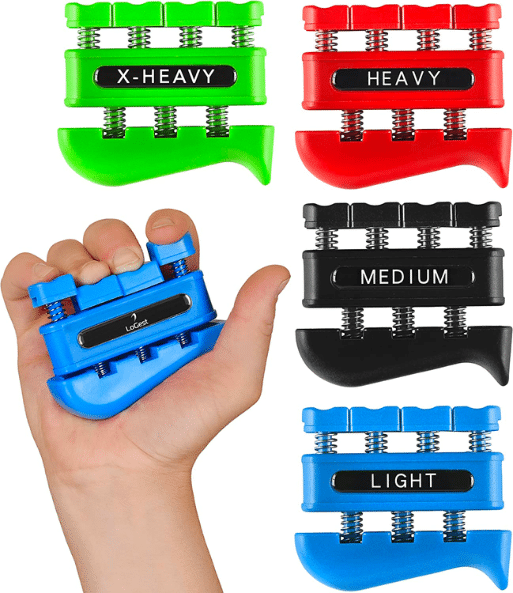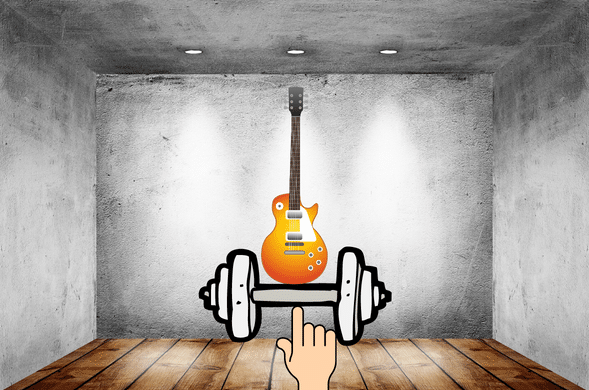One of the most important things you can do to accelerate your playing progress is to build finger strength for guitar! In this article, I’ll show you the finger warm-up and strengthening exercises I use before I begin my daily practice routine or performance. Learn to do these, and your rhythm and lead guitar playing will quickly improve!
You can use the table of contents below to take you to the area that interests you. Click on the little box to open it, and then click on the section of the article you want to read, or you can read from start to finish if you want the full finger exercise experience!
If you’re in a hurry, you can click here to go directly to my finger strength exercises.
The Short Answer
Daily finger warm-up and strengthening exercises will make you a better rhythm and lead guitar player in any musical style. Developing a routine using the correct exercises is essential to achieve good progress. Strengthening the pinky finger will help you play complex musical passages precisely and quickly.
Keep On Reading (Below) To Learn More
What Is Finger Strength?

Finger strength means how much force you can exert with the fingers of each hand. It allows our hands to be useful for things like grasping objects and squeezing a rubber ball in the palm of the hand.
Why Is Finger Strength Important?
We need a certain amount of finger strength when we use our picking (typically right) hand and fretting (typically left) hand to play the guitar.
Playing the guitar requires a lot of finger strength and dexterity. If you don’t have enough power in your fingers, you won’t be able to press down on the strings hard enough to produce a clean, clear sound.
This can lead to frustration and make it difficult to progress as a guitar player. By building your finger strength, you’ll be able to play more complex chords, faster scales, and more intricate melodies.
Finger Strength Versus Dexterity
Finger strength and dexterity are two different things, but they work together to help make your playing great! Here’s the low down on what they are and why they’re important.
Finger Strength
Finger strength gives you the ability to manipulate the guitar strings properly. This could be something as simple as pressing the strings down onto the frets or holding the pick without it slipping between your finger and thumb.
Bending the strings or doing finger vibrato requires more strength than just pushing them down onto the fretboard.
Thicker gauge strings or a guitar with a higher action (string height) require more finger strength.
Fingertip callus formation helps you use finger strength without hurting or damaging your skin.
Finger Dexterity
Finger dexterity is the ability to move your fingers quickly and precisely. Dexterity can be improved by performing a variety of exercises. For example, practicing scales or arpeggios slowly with a metronome and then building up the speed can help increase the dexterity in both hands and fingers.
Metal players that shred notes all over the neck at top speeds typically spend hours building up their finger dexterity.
Don’t Confuse Finger, Wrist, & Forearm Strength!

Great guitar players know how to isolate finger, wrist, and forearm movements. For example, when you pick the strings, do you strum chords by moving your elbow or keep your elbow still and rotate your forearm and wrist? It can depend on what type of music you’re playing and the sound you’re looking to get.
One of the biggest mistakes I see beginning players make is trying to do effective finger vibrato by moving their fingers back and forth on the neck instead of rotating the forearm and using the power of those larger muscles.
So, when we talk about “finger” strength, it can be in combination with other muscles of the hand, wrist, and forearm.
Developing Fretting Vs. Picking Finger Strength

Finger strength on the right and left sides should be built up simultaneously. Most players that use a pick (plectrum) tend to favor the development of fretting hand strength, but finger-pickers spend more time developing strength and dexterity in the right hand.
Two-handed fretboard tappers tend to do a good job of developing finger strength and dexterity on both sides.
I want you to focus primarily on what works best for your playing style, but pay attention to developing finger strength basics in both hands.
Hand And Finger Warmups
Before you begin strengthening exercises for the guitar, I recommend that you do these three exercises to warm up your hands and fingers. They will prepare your muscles for playing and can help to prevent injuries.
Do these exercises with all the fingers on both hands. You usually don’t have to spend more than five minutes a hand on these warmups.
Finger Stretching
Begin by holding one hand in front of you with the palm facing down. Then, use the other hand to gently pull each finger up and hold it for a few seconds before releasing it. Don’t pull up too far. Stop if it begins to feel uncomfortable.
Hand And Wrist Rotation
Make a fist with your hand and rotate your wrist in a circular motion, first clockwise, then clockwise, and then in an alternating clockwise and counterclockwise motion. Begin slow and gradually pick up speed.
Hand Squeezes
This exercise is good for warming up and building strength. Use a ball that fits nicely in the palm of your hand and gently squeeze for a few seconds before releasing it slowly. I like to use a foam stress ball because it gives me more control over the pressure I want to exert.
Finger Strength Exercises
This section contains a lot of information, so please don’t try to learn it all at once. I recommend you start at the top and take things slowly! You can always come back to these finger strength exercises to learn more.
After warming up your hands and fingers, you can begin doing finger strength exercises. Here are the five types of finger exercises I recommend.
Take your time with them to get the most benefit from these exercises. It’s important to do them correctly and completely. However, stop if you experience any discomfort.
Finger Pushups
Finger pushups are like regular pushups done in reverse. The idea is that pushing down on the strings helps you build strength using the angles that your fingers naturally fall on the fretboard.
Pick a string and begin with your first (index) finger behind the first fret. Push down on the string and then release it. Staying on the same string, repeat the process three more times using your second (middle) finger behind the second fret, third (ring) finger behind the third fret, and fourth (pinky) finger behind the fourth fret.
It’s essential to continue repeating the exercise by moving up the fretboard one fret at a time until you reach the top. This is because as you move farther up the fretboard, your fingers will be closer together, and the angle of your wrist and fingers will change. Then reverse the process by coming back down the fretboard.
Do finger pushups up and down the fretboard for each string to complete the entire process. Once you get this exercise down, you can add the Spider Walk, which is outlined below.
Using A Finger Strength Machine
In addition to doing the finger pushups on the guitar neck, you can also use a finger strengthener machine. The advantage of this type of device is that it can be used anywhere, so you can do finger pushups when your guitar is unavailable. It also exercises the muscles of your fingers, hands, wrists, and forearms more vigorously than doing it on a guitar.
Here is the finger exerciser system that I’ve been using, and I love it. The great thing is that you get four separate exercising machines. Each device is built to provide a different tension level for light, medium, heavy, and extra-heavy workouts.
If you overdo it, you can always use a lighter tension device the next time. I like this system quite a bit, and it isn’t costly.

Click HERE To Check Reviews & Price On Amazon
Spider Walk
This is a variation of the finger pushups exercise, but it takes it to the next level and is also helpful for improving finger dexterity.
Once you are comfortable doing the finger pushups (see above), this exercise works the same way, except you form “patterns” with your fingers by mixing up the order.
Spider Walk With All Fingers On The Same String
Start with the 1st finger and form these patterns on the same string using all four fingers. Begin in the first four frets and move the finger patterns up the guitar neck one fret at a time and then back down again.
Don’t forget to repeat the process on each string.
Use alternate (up, down, up, down) picking, and then try it using hammer-ons and pull-offs instead of picking the strings.
So, here we go! Pick a string and stay on it until you go up and down the fretboard, then go to the next string. The first exercise uses the first (index) finger for the first fret, the second finger for the second fret, etc.
| Starting Finger | Next Finger | Next Finger | Ending Finger |
|---|---|---|---|
| 1st | 2nd | 3rd | 4th |
| 1st | 2nd | 4th | 3rd |
| 1st | 3rd | 2nd | 4th |
| 1st | 3rd | 4th | 2nd |
| 1st | 4th | 2nd | 3rd |
| 1st | 4th | 3rd | 2nd |
| ― | ― | ― | ― |
| 2nd | 1st | 3rd | 4th |
| 2nd | 1st | 4th | 3rd |
| 2nd | 3rd | 1st | 4th |
| 2nd | 3rd | 4th | 1st |
| 2nd | 4th | 1st | 3rd |
| 2nd | 4th | 3rd | 1st |
| ― | ― | ― | ― |
| 3rd | 1st | 2nd | 4th |
| 3rd | 1st | 4th | 2nd |
| 3rd | 2nd | 1st | 4th |
| 3rd | 2nd | 4th | 1st |
| 3rd | 4th | 1st | 2nd |
| 3rd | 4th | 2nd | 1st |
| ― | ― | ― | ― |
| 4th | 1st | 2nd | 3rd |
| 4th | 1st | 3rd | 2nd |
| 4th | 2nd | 1st | 3rd |
| 4th | 2nd | 3rd | 1st |
| 4th | 3rd | 1st | 2nd |
| 4th | 3rd | 2nd | 1st |
Spider Walk On Different Strings
Once you have mastered the exercises in the table above, use the same finger patterns, but this time use more than one string at a time.
For example, using the pattern 1st, 2nd, 3rd, 4th:
| Exercise Number | 1st Finger (1st Fret) | 2nd Finger (2nd Fret) | 3rd finger (3rd Fret) | 4th Finger (4th Fret) |
|---|---|---|---|---|
| Exercise One: | High-E String | B String | G string | D String |
| Exercise Two: | B String | G String | D String | A String |
| Exercise Three: | G String | D String | A String | Low-E String |
Then, reverse the patterns:
| Exercise Number | 4th Finger (4th Fret) | 3rd Finger (3rd Fret) | 2nd finger (2nd Fret) | 1st Finger (1st Fret) |
|---|---|---|---|---|
| Exercise One: | Low-E String | A String | D String | G String |
| Exercise Two: | A String | D String | G String | B String |
| Exercise Three: | D String | G string | B String | High-E String |
After you master this, move the patterns up and down the fretboard, and then try using the other four-finger patterns in the first table (1st, 2nd, 4th, 3rd, then 1st, 3rd, 2nd, 4th, etc.).
Spider Walk With Finger Stretching On The Same String
Adding a finger stretch between two fingers on an exercise pattern can build even more finger strength.
For example, using the high-E string, starting at the fifth fret.
| 5th Fret | 6th Fret | 7th Fret | 8th Fret | 9th Fret |
|---|---|---|---|---|
| 1st Finger | “Skip Fret” | 2nd Finger | 3rd Finger | 4th Finger |
| 1st Finger | 2nd Finger | “Skip Fret” | 3rd Finger | 4th Finger |
| 1st Finger | 2nd Finger | 3rd Finger | “Skip Fret” | 4th Finger |
Then, reverse the patterns:
| 9th Fret | 8th Fret | 7th Fret | 6th Fret | 5th Fret |
|---|---|---|---|---|
| 4th Finger | “Skip Fret” | 3rd Finger | 2nd Finger | 1st Finger |
| 4th Finger | 3rd Finger | “Skip Fret” | 2nd Finger | 1st finger |
| 4th Finger | 3rd Finger | 2nd Finger | “Skip Fret” | 1st Finger |
Now, do the same finger patterns for each of the other 5 (B, G, D, A, and Low-E) strings.
Once you have these mastered, play them up and down the neck. The lower down the neck you begin, the bigger the finger stretch will be, and vice versa.
Spider Walk Using Random Patterns On Different Strings
Once you get good at the spider walk, you can play random patterns or arpeggios that use notes on different strings. You know the drill by now; move everything up and down the fretboard.
Stop and rest if you develop pain, tingling, or numbness in your fingers, hand, or wrist. Remember, tomorrow is another day, so don’t overdo it!
Someday, I’ll make a YouTube video showing how to do this and link it to this article.
Play Barre Chords
By now, you’re probably sick of the spider walk, so let’s try some barre chords!
Remember how torturous it was to learn to play the F Chord? Assuming you can play an F chord in the first three frets by barring the high-E and B strings with your index finger, learning to play chords with a full barre is a great way to build finger strength.
This is because barre chords require you to press down on multiple strings simultaneously with one finger to create the chord. The first two barre chord shapes players usually learn are the “E-Form” with the chord’s root on the first and sixth strings and the “A-Form” with the root on the fifth string.
If you don’t know what I’m talking about, get yourself a good chord book or search for the types of barre chords on the Internet.
Of course, there are many other types of major, minor, dominant, augmented, and diminished barre chords that can be moved all over the neck. Each distinct barre chord shape can help build finger strength differently.
Hammer-Ons, Pull-Offs, Trills, And Finger Tapping
Practice all the finger strength exercises with a guitar pick (using alternate picking) and without a pick, using hammer-ons, pull-offs, trills, and finger tapping. A trill uses two fingers and rapidly alternates between two adjacent notes on the same string.
Eddie Van Halen was the inventor and king of finger tapping for Rock and Metal. Check out some of his videos on YouTube for some great tapping ideas.
These techniques are a great way to build finger strength and dexterity, too!
Tips For Building Finger Strength
Here are some things you can do to help speed up the process of developing finger strength on the guitar and avoid problems along the way.
Start slow; it’s not a race! Overdoing it will only set you back. Instead, begin with simple exercises and gradually add more. You have to give your fingers time to develop calluses to prevent pain and damage to your skin. You can speed up the exercises when you can play them accurately and comfortably.
Always use the correct hand and finger positions to avoid injuries and build strength efficiently.
Practice consistently but take breaks to give your fingers a rest between exercises. The more you practice, the stronger your fingers will become.
Don’t try playing music that is too complex or fast before you’ve built up adequate finger strength and dexterity.
Use That Pinky!
Get used to using your fifth finger when fretting notes on the guitar neck! Although this is the hardest finger to strengthen, it’s worth the effort! Although some great guitar plays don’t use their pinky, you’ll find that life will become much easier by using it every chance you get.
I tried to avoid using my left pinky when I first started playing the guitar. However, I soon realized that I was severely limiting my playing potential. Using all four fingers on the fretboard made my solos much more fluid and precise and opened up new fingering patterns that had a tremendously positive effect on the way I composed music!
Trust me; you’ll wonder how you ever got along without using your pinky!
Combining Strength and Dexterity Exercises

The key to supercharging your guitar playing is to work on exercises that increase both your finger strength and dexterity.
Anything that helps increase finger independence will improve dexterity. The spider walk, hammer-ons, pull-offs, trills, finger skipping exercises, and finger tapping are all helpful in this regard.
Learning to play chord progressions using the Circle of Fifths and CAGED shapes, as well as playing scales and arpeggios, all require finger strength and dexterity.
Great guitar players, like Joe Satriani and Eric Johnson, have the finger strength and dexterity to play all over the neck and sound incredible! You can play like them, but you have to practice, practice, practice!
Remember to use a metronome whenever learning something new. Start slow and build it up to speed, but keep it precise and on time. It will help combine finger strength with dexterity. If you don’t have a metronome, you can download a free digital app for your smartphone or tap your foot as you play.
Don’t Overdo It!

Here are a few important things to be aware of, as you work on your finger strength.
Always do the warm-up exercises before you start the finger exercises. You can start out slow and limit your exercise time. Five to fifteen minutes is good when first beginning. After that, you can slowly increase your exercise time as needed.
Stop immediately if you develop any pain, tingling, numbness, or swelling in your fingers, hands, wrists, or forearms! Also, check with your doctor before starting these exercises if you have a history of medical problems involving your skin, bones, or joints in your upper body.
Frequently Asked Questions

Here are some of the questions I get asked about finger strength.
If your question does not appear here, please put it in the comments, and I will get right back to you with an answer.
How Do You Maintain Finger Strength?
To maintain finger strength, it’s essential to do guitar finger-strengthening every day before you start your practice or performance session. Playing the guitar also contributes to finger strength, especially if you play barre chords and scales up and down the neck.
Is Finger Strength Different From Grip Strength?
Finger strength is the force each finger on your hands can exert separately. Grip strength is created by the power that comes from the combination of all the fingers on one or both hands.
How Long Does Finger Strength Take To Build?
Building finger strength for playing the guitar can take a variable amount of time. It depends on how often you play and what type of guitar you use. Acoustic guitars typically build finger strength quicker than electric guitars because they are more challenging to play.
Using thin gauge strings with a low action will increase the time it takes to build finger strength and vice versa
Which Finger Has The Most Strength?
The index and middle fingers typically have the most finger strength, especially for grip, but it can vary from person to person.
What Causes Loss Of Strength In Fingers?
Guitar players that don’t play regularly or don’t do finger-strengthening exercises can lose finger strength. Medical conditions like carpal tunnel syndrome can contribute to finger weakness. The normal aging process can cause muscle atrophy that can weaken finger strength.
Which Finger Has The Least Strength?
The little finger (pinky) is the weakest finger on the hand. As a guitar player, it’s essential to do finger-strengthening exercises to strengthen all the fingers of your fretting hand, but especially the pinky.
Final Thoughts

I hope this article on how to build finger strength for guitar helped clarify things for you.
Finger strength is the amount of force a that each finger on the hand can exert. Fretting and picking the guitar both require a certain amount and type of finger strength.
Finger strength differs from dexterity, but they work together to allow you to play the guitar well. Some finger-strengthening exercises can also improve dexterity and vice versa.
A lot of the strength that players think comes from the fingers actually comes from the wrist and forearm, especially during string bending and vibrato.
Doing finger and hand warm-ups before beginning the strengthening exercises is important. Combining strengthening and dexterity exercises is one of the best ways to help improve your guitar playing!
However, it’s essential not to overdo it. Start slow with a limited number of exercises and slowly add more. Stop immediately if you develop pain, tingling, numbness, or swelling in your fingers, hands, wrists, or forearms!
I recommend you begin using your pinky finger when you first start playing guitar to help build strength in this finger, along with the others!

Here’s a great video from “Learn Guitar In London!” Drue James shows you the basic exercises to build strength in your fretting hand and tips to strengthen your pinky finger!
Related Article ➡ Build Finger Dexterity For Guitar – How To Rip Guitar Solos!
Tell Me What You Think

Please leave a comment below if you enjoyed this article, have any questions about finger strengthening, or want to give your point of view. I will be happy to help you.
- Are you using your pinky finger when you play the guitar?
- Do you have a particular exercise to help strengthen the pinky?
- What routine are you using to warm up and strengthen your fingers?
- Do you think an acoustic guitar is a good way to improve finger strength?
- What else is on your mind?



I took up guitar about a year ago just for fun. I practice about 3 hours a week and have a good time with it. I noticed that after prolonged absences from practicing, my fingers seem “flimsy” when I get at it again.
Besides maybe not practicing enough, what other common mistakes do beginners make when trying to build finger strength on the guitar?
Hi, Matt
Thank You for your comments and question!
If you are practicing three hours a week, that should be enough to maintain your finger strength. However, if it isn’t, you can add more practice time and try to divide it so you’re playing every day or on most days.
Doing the finger strength exercises in this article will definitely help. Consistency is the key!
Building finger strength on an electric guitar with a low action (string height) and very thin gauge strings (like a 0.008 high-E set) can be challenging. “Lead” guitar players may have less finger strength than rhythm guitarists that play various barre chords all over the neck.
Playing an acoustic guitar will really help you build finger strength for an electric guitar.
Rock On! 🤘
Frank 🎸
I agree finger strength and very important when playing the guitar. When I first started playing, the sounds that I was playing did not come out as clear and loud as I wanted them to. it was because I wasn’t applying enough pressure on the chords. It wasn’t that I wasn’t strong enough. I was just afraid that I would put too much pressure so I slacked up a bit. But ultimately the quality of sound will come from your finger strength.
Especially when you are playing for a long time.
Hi, KD
Thank You for your comments!
Yes, building finger strength is definitely a plus, especially for professional guitarists who play for hours at a time. Finger strength and placement on the guitar neck can truly affect the quality of the sound.
Practicing or performing daily is essential to keep your finger strength up to par.
Best,
Frank 🎸